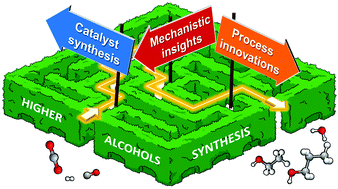Status and prospects in higher alcohols synthesis from syngas
Abstract
Higher alcohols are important compounds with widespread applications in the chemical, pharmaceutical and energy sectors. Currently, they are mainly produced by sugar fermentation (ethanol and isobutanol) or hydration of petroleum-derived alkenes (heavier alcohols), but their direct synthesis from syngas (CO + H2) would comprise a more environmentally-friendly, versatile and economical alternative. Research efforts in this reaction, initiated in the 1930s, have fluctuated along with the oil price and have considerably increased in the last decade due to the interest to exploit shale gas and renewable resources to obtain the gaseous feedstock. Nevertheless, no catalytic system reported to date has performed sufficiently well to justify an industrial implementation. Since the design of an efficient catalyst would strongly benefit from the establishment of synthesis–structure–function relationships and a deeper understanding of the reaction mechanism, this review comprehensively overviews syngas-based higher alcohols synthesis in three main sections, highlighting the advances recently made and the challenges that remain open and stimulate upcoming research activities. The first part critically summarises the formulations and methods applied in the preparation of the four main classes of materials, i.e., Rh-based, Mo-based, modified Fischer–Tropsch and modified methanol synthesis catalysts. The second overviews the molecular-level insights derived from microkinetic and theoretical studies, drawing links to the mechanisms of Fischer–Tropsch and methanol syntheses. Finally, concepts proposed to improve the efficiency of reactors and separation units as well as to utilise CO2 and recycle side-products in the process are described in the third section.



 Please wait while we load your content...
Please wait while we load your content...